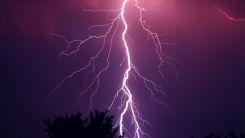
Kendra Stacy


Mercury To Peak at Its Highest Point During the Weekend; Here's How To Watch the Swift Planet

Asteroid Bennu Has Small Chance of Crashing Into Earth, Unleashing Explosion Equivalent to Over 20 Nuclear Bombs, NASA Says

Human Body Number of Cells: Massive New Analysis Reveals How Many Cells a Person Has

Can Sand Flow Uphill? Engineering Researchers Discover How

Can You Speak Chicken Language? New AI May Translate What These Fowls Are Saying, Scientists Claim

Ancient Egyptian Sunken Underwater Temple Found To Hold Extraordinary Treasures and Secrets

Can I Shower During a Thunderstorm? Is It Safe or Not?

Ponds Are Net Greenhouse Gas Emitters Due to Methane Release, Study Reveals

Origins of Neurons? Brain Cell Building Blocks Could Be Traced Back to Placozoans From 800 Million Years Ago, Study Reveals

Over 110 Ancient Cave Paintings, Engravings Found in Paleolithic Rock Art Sanctuary in Spain Date Back to At Least 24,000 Years Ago

Ultra Rare Pink Diamonds May Have Emerged as a Result of Supercontinent 'Nuna' Breakup, Researchers Reveal

Urinary System: Where Does Pee Come From?

Could Working From Home Be Good For the Environment? Remote Work Done Right Can Reduce Carbon Footprint, Study Reveals

Frankish Medieval Warrior Found in Germany Was Buried With Weapons, May Have Died During Early Merovingian Period

Great White Shark Populations Have Been Declining and Migrating; Predatory Orcas Could Be a Reason Why

Is Autism a Neurological Disorder? When Do Autism Spectrum Disorder Symptoms First Appear?

Night Owls Are More Likely To Develop Type 2 Diabetes, Unhealthy Habits Compared to Early Birds, Study Reveals

Budget Ozempic Trend For Weight Loss: Is It Safe and Effective?

Stay Tuned: Northern Lights May Be Visible From the US on Tuesday Due to Solar Storm

NASA Parker Solar Probe Becomes the First To Fly Through Coronal Mass Ejection From Sun, Allowing the Closest CME Observations Ever Seen

Canine Intelligence: Dogs May Have Human-Like Observational Spatial Memory, Study Reveals

Clade 9 VZV Strain: New Chickenpox Virus Variant Found in India for the First Time

Rivers Are Getting Oxygen-Deprived and Warmer, Putting Aquatic Life at Risk

Antibiotic Resistant Bacteria That Could Cause Hospital Acquired Infection Found in Hospital Wastewaters, Study Reveals

Most Venomous Animal in the Water: Box Jellyfish Venom Contains Toxins That Attack Nervous System, Heart, Skin

Mysterious 4,000-Year-Old Canaanite Arch Found To Be Incredibly Well-Preserved, Hints Prehistoric Celtic Traditions

NASA UFO Report: No Evidence of Aliens; UAP Remains a Mystery

Complete Nonsense: Two 'Alien Bodies' Presented by Self-Proclaimed UFO Expert During Mexican Congress UAP; Scientists Denounce Claims

Why Do I Feel Sick After Working Out? Here's Why Post-Workout Nausea or Sickness Happens at Times
Most Popular

Ancient Hotspot Found to Have Created Great Lakes 300 Million Years Ago

Mysterious Structures Discovered Beneath the Pacific Ocean, Puzzle Scientists

Health Benefits of Drinking Hot Chocolate

Largest Known Volcanic Aquifer Discovered Beneath Oregon's Cascades




